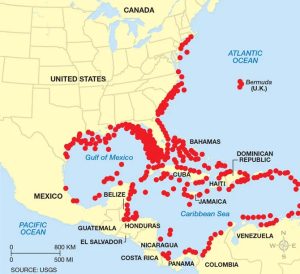(Oranjestad)—Despite its colorful and striking appearance, the lionfish has become a Caribbean-wide problem for Atlantic sea life. The Aruban marine wild life is also affected by this beautiful dilemma, as it is foreign to our waters and has become a danger to our local fish and reefs.

Originating from the Indo-Pacific Ocean, the lionfish is a relatively small fish. It has no teeth, but it does protect itself against predators using its sharp, colorful spikes. It is said that the sting of a lionfish can be up to 100 times more painful than that of a bee’s sting.
Its natural predators in the Indo-Pacific are sharks and barracudas, but in the Caribbean Sea, local fish do not recognize the lionfish as part of their diet. In other words, the lionfish has no predators in the Caribbean Sea. And this becomes a major problem for our local marine life; if there are no predators to stimulate population control of lionfish, these fish can continue to reproduce and expand to other parts of the Atlantic, become more invasive and dangerous for other types of fish.
For Aruba, the lionfish is a problem especially for our local coral reefs. According to Patrick van Brakel, lionfish expert and hunter from the Hunting Lionfish Aruba foundation, every reef has a “cleaning station”—tiny fish that eat algae and other types of waste on a reef, thus maintaining the reef’s health and providing food to the fish population in the area. However, as the lionfish feeds off of these tiny fish, it becomes harder for the coral reef to maintain its health.
Patrick also shares the origins of lionfish in the Caribbean Sea. It is theorized that the introduction of these fish in the Atlantic happened in Florida, where people would buy lionfish from across the world to keep in their aquariums. However, lionfish grow, and as these buyers realized that the fish were too much upkeep, they were let out into the ocean to roam free. From continental USA, the lionfish travelled to and invaded the entire Caribbean area, from Aruba, Bonaire and Curacao up to New York. In Aruba, lionfish were discovered in 2009.
Controlling the lionfish population is challenge, as each female fish can lay up to 40,000 eggs a day. Luckily, we have people like van Brakel who dedicate their lives hunting and capturing these invasive species, using them for consumption and jewelry making.
They are caught with a hand spear, an object resembling a garbage picker with 4 sharp prongs. These spears are used like a sling shot to catch lionfish from a distance. These fish are then put into a collecting tube and taken out of the water. Van Brakel not only catches them himself, but also cooks them for locals and tourists at The LionFish Snack Aruba in Paradera. This way, he does his part in protecting the local wild life.




















